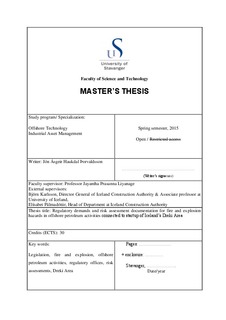| dc.contributor.author | Thorvaldsson, Jon Asgeir Haukdal | |
| dc.date.accessioned | 2015-08-20T10:49:56Z | |
| dc.date.available | 2015-08-20T10:49:56Z | |
| dc.date.issued | 2015-06-15 | |
| dc.identifier.uri | http://hdl.handle.net/11250/297598 | |
| dc.description | Master's thesis in Offshore technology : industrial asset management | nb_NO |
| dc.description.abstract | Serious search has begun for oil and gas deposits within Iceland’s exclusive economic zone, more specifically in the Dreki area 335km north-east of Iceland. Icelandic authorities do not have the structure or experience to administrate and supervise offshore petroleum activities. It is however very important that these authorities are prepared if application for exploration drilling are handed in. To avoid starting at the beginning of the learning curve Icelandic authorities should look towards countries that are experienced in administrating and supervising such activities. Norwegian authorities have been quite responsive in adjusting their regulatory framework and regulatory regime to respond to recommended changes following major accidents and new challenges. Norwegian authorities base their regulatory framework on performance base regulations that are then supplemented with few specific requirements. This allows and encourages innovation and possible cost reductions. The chosen solution is however required to result the same performance or better than is required by legislation. The Norwegian management structure for offshore petroleum activities is quite simple. That is partly due to the fact that the Petroleum Safety Authority (PSA) takes on all matters concerning health, safety and the environment and from within collaborates and cooperates with other authorities regarding their respective area of expertise. Icelandic authorities should look towards the Norwegian approach to ensure safe extraction of oil and gas. There is noticeable movement internationally to separate the responsibilities of natural resource management and supervision of offshore petroleum activities. Icelandic authorities should implement performance based regulations and setup a simple management structure. It is suggested that the NEA holds the responsibility of awarding licenses for exploration and production. It is as well suggested that either the ICA or the AOSH take over the supervising responsibility and collaboration with other authorities as they hold considerable experience in processing and evaluating technical documents and information. | nb_NO |
| dc.description.sponsorship | Iceland Construction Authority | nb_NO |
| dc.language.iso | eng | nb_NO |
| dc.publisher | University of Stavanger, Norway | nb_NO |
| dc.relation.ispartofseries | Masteroppgave/UIS-TN-IKM/2015; | |
| dc.subject | Dreki area | nb_NO |
| dc.subject | offshore teknologi | nb_NO |
| dc.subject | fire and explosion | nb_NO |
| dc.subject | offshore petroleum activities | nb_NO |
| dc.subject | driftsledelse | nb_NO |
| dc.subject | regulatory offices | nb_NO |
| dc.subject | risk assessments | nb_NO |
| dc.subject | Iceland | |
| dc.subject | Island | |
| dc.title | Regulatory demands and risk assessment documentation for fire and explosion hazards in offshore petroleum activities connected to startup of Iceland’s Dreki Area | nb_NO |
| dc.type | Master thesis | nb_NO |
| dc.subject.nsi | VDP::Technology: 500::Marine technology: 580::Offshore technology: 581 | nb_NO |
